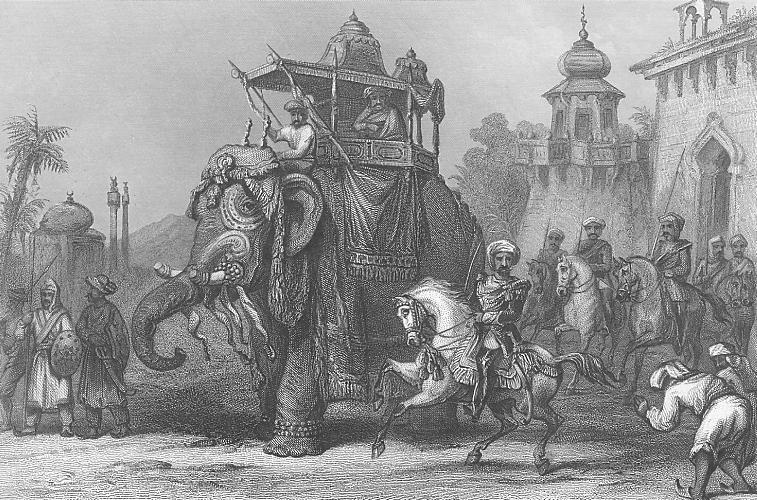<Back to Index>
- Rani of Jhansi Lakshmi Bai, 1835
- Peshwa of the Maratha Confederacy Nana Sahib (Dhondu Pant), 1824
PAGE SPONSOR
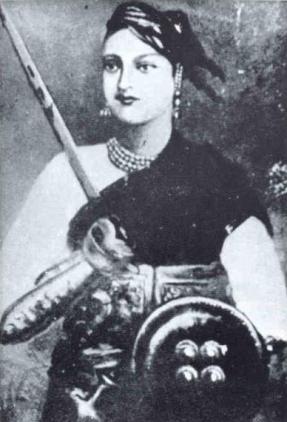
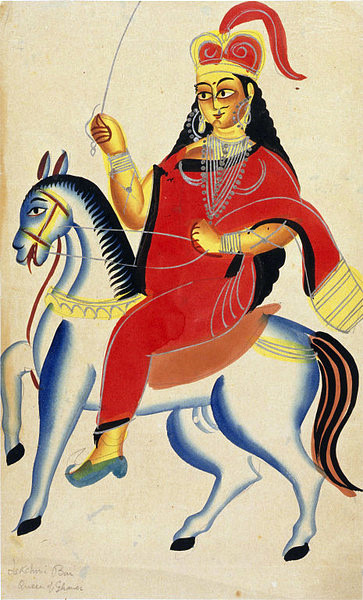
Lakshmi Bai, the Rani of Jhansi (c.19 November 1835 – 17 June 1858) (Marathi झाशीची राणी लक्ष्मीबाई) was the queen of the Maratha ruled princely state of Jhansi, situated in the northern part of India. She was one of the leading figures of the Indian Rebellion of 1857 and a symbol of resistance to the rule of the British East India Company in the subcontinent.
Originally named Manikarnika and nicknamed Manu, Lakshmibai was born at Kashi (Varanasi) to Moropant Tambe and Bhagirathibai Tambe, a Maharashtrian Karhade Brahmin couple. She lost her mother at the age of four. Her father worked at the Peshwa court of Bithoor; the Peshwa brought her up like his own daughter, and called her "Chhabili" for her light - heartedness. She was educated at home.
Because of her father's influence at court, Lakshmibai had more independence than most women, who were normally restricted to the zenana. She studied self - defense, horsemanship, archery, and even formed her own army out of her female friends at court. Tatya Tope, who would later come to her rescue during the 1857 Rebellion, was her mentor.
Lakshmibai was married to Raja Gangadhar Rao Newalkar, the Maharaja of Jhansi, in 1842, and thus became the queen of Jhansi. After their marriage, she was given the name Lakshmibai. The Raja was very affectionate towards her. She gave birth to a son, Damodar Rao, in 1851. However, the child died when he was about four months old. After the death of their son, the Raja and Rani of Jhansi adopted Anand Rao. Anand Rao was the son of Gangadhar Rao's cousin, and was later renamed as Damodar Rao. However, it is said that the Raja of Jhansi never recovered from his son's death, and he died on 21 November 1853.
Because Anand Rao was adopted, the British East India Company, under Governor - General Lord Dalhousie, applied the Doctrine of Lapse,
rejecting Rao's claim to the throne and annexing the state to its
territories. In March 1854, Lakshmibai was given a pension of 60,000
rupees and ordered to leave the palace and the Jhansi fort.
On May 10, 1857 the Indian Rebellion started in Meerut. This began after rumors that the new bullet casings for the Lee Enfield rifles were coated with pork and beef fat; British commanders insisted on their use and started to discipline anyone who disobeyed. During this rebellion sepoys killed many British soldiers and officers of the East India Company.
Unrest began to spread throughout India. During this chaotic time, the British were forced to focus their attentions elsewhere, and Lakshmibai was essentially left to rule Jhansi alone. During this time, she was able to lead her troops swiftly and efficiently to quell skirmishes breaking out in Jhansi. She kept Jhansi relatively calm and peaceful in the midst of the the unrest in northern India; For example, she conducted the haldi - kumkum ceremony with great pomp and ceremony before all the women of Jhansi to provide assurance to her subjects and to convince them that Jhansi was under no threat of an attack.
Up
to this point, Lakshmibai had been hesitant to rebel against the
British, and there is still some controversy over her role in the
massacre of Company officials, their wives and children on 8 June 1857
at Jokhan Bagh. Her hesitation finally ended when British troops arrived under Sir Hugh Rose and laid siege to Jhansi on 23 March 1858. She rallied her troops and fought fiercely. An army of 20,000, headed by Tatya Tope,
was sent to relieve Jhansi and to take Lakshmibai to freedom. However,
the British, though numbering only 1,540 in the field so as not to break
the siege, were better trained and disciplined than the raw recruits,
and these inexperienced soldiers turned and fled shortly after the
British began to attack on 31 March. Lakshmibai’s forces could not hold
out and three days later the British were able to breach the city walls
and capture the city. Lakshmibai escaped by jumping from the wall at
night with her son. She fled from her city, surrounded by her guards,
many of them women.
Along with the young Anand Rao, the Rani decamped to Kalpi along with her troops, where she joined other rebel forces, including those of Tatya Tope. The Rani and Tatya Tope moved on to Gwalior, where the combined rebel forces defeated the army of the Maharaja of Gwalior after his armies deserted the rebel forces. They then occupied a strategic fort at Gwalior. However, on 17 June 1858, while battling in full warrior regalia against the 8th (King's Royal Irish) Hussars in Kotah-ki Serai near the Phool Bagh area of Gwalior, she died. The British captured Gwalior three days later. In the British report of the battle, General Sir Hugh Rose commented that the Rani, "remarkable for her beauty, cleverness and perseverance", had been "the most dangerous of all the rebel leaders".
However, the lack of a corpse to be convincingly identified as that of Lakshmibai convinced Captain Rheese that she had not actually perished in the battle for Gwalior, stating publicly that: "[the] Queen of Jhansi is alive!". It is believed her funeral was arranged on the same day near the spot where she was wounded. Lakshmibai was memorialized in bronze statues at Jhansi and Gwalior, both of which portray her on horseback. Other equestrian statues can be seen in Agra and Pune.
Her
father, Moropant Tambey, was captured and hung a few days after the
fall of Jhansi. Her adopted son, Damodar Rao (formerly known as Anand
Rao), fled with his mother's aides. Rao was later given a pension by the British Raj and cared for, although he never received his inheritance. Damodar Rao settled down in the city of Indore,
and spent most of his life trying to convince the British to restore
some of his rights. He and his descendants took on the last name
Jhansiwale. He died on 28 May 1906, at the age of 58.
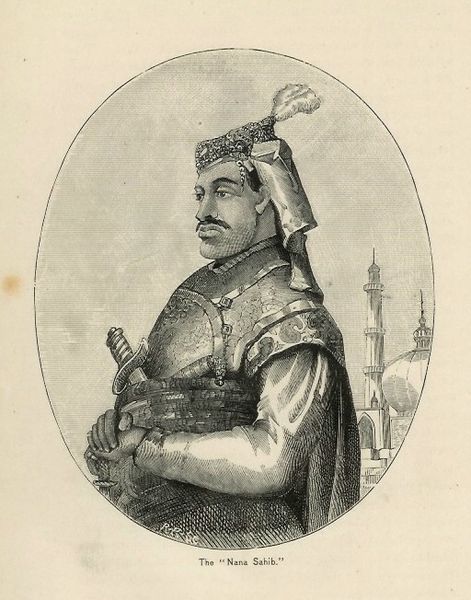
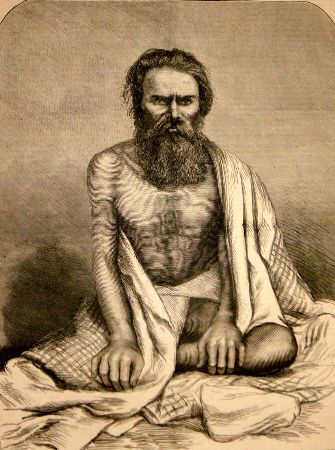
Nana Sahib (born 1824), born as Dhondu Pant (Marathi धोंडू पंत ), was an Indian leader during the Rebellion of 1857. As the adopted son of the exiled Maratha Peshwa Baji Rao II, he sought to restore the Maratha confederacy and the Peshwa tradition.
Nana Sahib was born as Dhondu Pant to Narayan Bhatt and Ganga Bai. In 1827, he was adopted by the Maratha Peshwa Baji Rao II. The East India Company exiled Baji Rao II to Bithoor near Cawnpore (now Kanpur), where Nana Sahib was brought up.
Nana Sahib's close associates included Tatya Tope and Azimullah Khan;
Tatya Tope was the son of Pandurang Rao Tope, an important noble at the
court of the Peshwa Baji Rao II. After Baji Rao was exiled to Bithoor,
Pandurang Rao and his family also shifted to Nepal.
Through
his adoption, Nana Sahib was heir presumptive to the throne, and was
eligible for an annual pension of £80,000 from the East India
Company. However, after the death of Baji Rao II, the Company stopped
the pension on the grounds that Nana Sahib was not a natural born heir.
Nana Sahib was highly offended, and sent his envoy (Azimullah Khan) to
England in 1853 to plead his case with the British Government. However,
Azimullah Khan was unable to convince the British to resume the pension,
and returned to India in 1855.
He won the confidence of Charles Hillersdon, the collector of Cawnpore. It was planned that Nana Sahib would assemble a force of 1,500 soldiers, in case the rebellion spread to Cawnpore.
On June 5, 1857, at the time of rebellion by forces of the East India Company at Cawnpore, the British contingent had taken refuge at an entrenchment in the southern part of the town. Amid the prevailing chaos in Cawnpore, Nana Sahib and his forces entered the British magazine situated in the northern part of the town. The soldiers of the 53rd Native Infantry, which was guarding the magazine, thought that Nana Sahib had come to guard the magazine on behalf of the British. However, once he entered the magazine, Nana Sahib announced that he was a participant in the rebellion against the British, and intended to be a vassal of Bahadur Shah II.
After taking possession of the Company treasury, Nana Sahib advanced up the Grand Trunk Road. He wanted to restore the Maratha confederacy under the Peshwa tradition, and decided to capture Cawnpore. On his way, Nana Sahib met the rebel Company soldiers at Kalyanpur. The soldiers were on their way to Delhi, to meet Bahadur Shah II.
Nana Sahib wanted them to go back to Kanpur, and help him in defeating
the British. The soldiers were reluctant at first, but decided to join
Nana Sahib, when he promised to double their pay and reward them with
gold, if they were to destroy the British entrenchment.
On June 5, 1857, Nana Sahib sent a letter to General Wheeler informing him to expect an attack next morning at 10 AM. On June 6, Nana Sahib's forces (including the rebel soldiers) attacked the British entrenchment at 10:30 AM. The British were not adequately prepared for the attack but managed to defend themselves as the attacking forces were reluctant to enter the entrenchment. Nana Sahib's forces had been led to falsely believe that the entrenchment had gunpowder filled trenches that would explode if they got closer. The British held out in their makeshift fort for three weeks with little water and food supplies, and lost many lives due to sunstroke and lack of water.
As the news of Nana Sahib's advances over the British garrison spread, several of the rebel sepoys joined him. By June 10, he was believed to be leading around twelve thousand to fifteen thousand Indian soldiers. During the first week of the siege, Nana Sahib's forces encircled the attachment, created loopholes and established firing positions from the surrounding buildings. The British Captain John Moore retaliated and launched night time sorties. Nana Sahib retreated his headquarter to Savada House (or Savada Kothi), which was situated around two miles away. In response to Moore's sorties, Nana Sahib decided to attempt a direct assault on the British entrenchment, but the rebel soldiers displayed a lack of enthusiasm.
The sniper fire and the bombardment continued until June 23, 1857, the 100th anniversary of the Battle of Plassey. The Battle of Plassey, which took place on June 23, 1757, was one of the pivotal battles leading to the expansion of the British rule in India. One of the driving forces of the rebellion by sepoys, was a prophecy that predicted the downfall of East India Company rule in India exactly one hundred years after the Battle of Plassey. This prompted the rebel soldiers under Nana Sahib to launch a major attack on the British entrenchment on June 23, 1857. However, they were unable to gain an entry into the entrenchment by the end of the day.
The British camp had been steadily losing its soldiers to successive bombardments, sniper fire, and assaults by Nana Sahib's forces. It was also suffering from disease and low supplies of food, water and medicine. General Wheeler's personal morale had been low, after his son Lieutenant Gordon Wheeler was decapitated in an assault on the barracks. At the same time, Nana Sahib's forces were wary of entering the entrenchment, as they believed that it had gunpowder filled trenches.
Nana Sahib and his advisers came up with a plan to end the deadlock. On June 24, Nana Sahib sent a female European prisoner, Rose Greenway, to the entrenchment to convey their message. In return for a surrender, he promised the safe passage of the British to the Satichaura Ghat, a dock on the Ganges from which they could depart for Allahabad. General Wheeler rejected the offer, because it had not been signed, and there was no guarantee that the offer was made by Nana Sahib himself.
Next
day, on June 25, Nana Sahib sent a second note, signed by himself,
through another female prisoner, Mrs. Jacobi. The British camp divided
into two groups with different opinions — one group was in favor of
continuing the defense, while the second group was willing to trust Nana
Sahib. During the next 24 hours, there was no bombardment from Nana
Sahib's forces. Finally, General Wheeler decided to surrender, in return
for a safe passage to Allahabad. After a day of preparation and burying
their dead, the British decided to leave for Allahabad on the morning
of June 27, 1857.
On the morning of the June 27 a large British column led by General Wheeler emerged out of the entrenchment. Nana Sahib sent a number of carts, dolis and elephants to enable the women, the children and the sick to proceed to the river banks. The British officers and military men were allowed to take their arms and ammunition with them, and were escorted by nearly the whole of the rebel army. The British reached the Satichaura Ghat (now Satti Chaura Ghat) by 8 AM. Nana Sahib had arranged around 40 boats, belonging to a boatman called Hardev Mallah, for their departure to Allahabad.
The Ganges river was unusually dry at the Satichaura Ghat, and the British found it difficult to drift the boats away. General Wheeler and his party were the first aboard and the first to manage to set their boat adrift. There was some confusion, as the Indian boatmen jumped overboard and started swimming toward the banks. During their jump, some of the cooking fires were knocked off, setting some of the boats ablaze. Though controversy surrounds what exactly happened next at the Satichaura Ghat, and it is unknown who fired the first shot, it is known that soon afterwards, the departing British were attacked by the rebel sepoys, and were either killed or captured.
Some of the British officers later claimed that Nana Sahib had placed the boats as high in the mud as possible, on purpose to cause delay. They also claim that Nana Sahib had previously arranged for the rebels to fire upon and kill all the English. Although the East India Company later accused Nana Sahib of betrayal and murder of innocent people, no definitive evidence has ever been found to prove that Nana Sahib had pre-planned or ordered the massacre. Some historians believe that the Satichaura Ghat massacre was the result of confusion, and not of any plan implemented by Nana Sahib and his associates.
Nevertheless, the fact that sniper fire from cannons pre-positioned along the riverbank was reported on the scene might suggest pre-planning. Whatever the case, amid the prevailing confusion at the Satichaura Ghat, Nana Sahib's general Tatya Tope allegedly ordered the 2nd Bengal Cavalry unit and some artillery units to open fire on the British. The rebel cavalry sowars moved into the water to kill the remaining British soldiers with swords and pistols. The surviving men were killed, while women and children were captured, as Nana Sahib did not approve of their killing. Around 120 women and children were taken prisoner and escorted to Savada House, Nana Sahib's headquarters during the siege.
The
rebel soldiers also pursued General Wheeler's boat, which was slowly
drifting to safer waters. After some firing, the British men on the boat decided to fly the white flag.
They were escorted off the boat and taken back to Savada house. The
surviving British men were seated on the ground, as Nana Sahib's
soldiers got ready to kill them. The women insisted that they would die
with their husbands, but were pulled away. Nana Sahib granted the
British chaplain Moncrieff's request to read prayers before they died. The British were initially wounded with the guns, and then killed with the swords. The women and children were taken to Savada House to be reunited with their remaining colleagues.
The surviving British women and children, around 120 in number, were moved from the Savada House to Bibighar ("the House of the Ladies"), a villa type house in Cawnpore. They were later joined by some other women and children, the survivors from General Wheeler's boat. Another group of British women and children from Fatehgarh, and some other captive European women were also confined to Bibighar. In total, there were around 200 women and children in Bibighar.
Nana Sahib placed the care for these survivors under a prostitute called Hussaini Khanum (also known as Hussaini Begum). He decided to use these prisoners for bargaining with the East India Company. The Company forces consisting of around 1000 British, 150 Sikh soldiers and 30 irregular cavalry had set out from Allahabad, under the command of General Henry Havelock, to retake Cawnpore and Lucknow. Havelock's forces were later joined by the forces under the command of Major Renaud and James Neill. Nana Sahib demanded that the East India Company forces under General Havelock and Neill retreat to Allahabad. However, the Company forces advanced relentlessly towards Cawnpore. Nana Sahib sent an army to check their advance. The two armies met at Fatehpur on July 12, where General Havelock's forces emerged victorious and captured the town.
Nana Sahib then sent another force under the command of his brother, Bala Rao. On July 15, the British forces under General Havelock defeated Bala Rao's army in the Battle of Aong, just outside the Aong village. On July 16, General Havelock's forces started advancing to Cawnpore. During the Battle of Aong, Havelock was able to capture some of the rebel soldiers, who informed him that there was an army of 5,000 rebel soldiers with 8 artillery pieces further up the road. Havelock decided to launch a flank attack on this army, but the rebel soldiers spotted the flanking maneuver and opened fire. The battle resulted in heavy casualties on both sides, but cleared the road to Cawnpore for the British.
By this time, it became clear that the Company forces were approaching Cawnpore, and Nana Sahib's bargaining attempts had failed. Nana Sahib was informed that the British troops led by Havelock and Neill were indulging in violence against the Indian villagers. Some believe that the Bibighar massacre was a reaction to the news of violence being perpetrated by the advancing British troops.
Nana Sahib, and his associates, including Tatya Tope and Azimullah Khan, debated about what to do with the captives at Bibighar. Some of Nana Sahib's advisors had already decided to kill the captives at Bibighar, as revenge for the murders of Indians by the advancing British forces. The women of Nana Sahib's household opposed the decision and went on a hunger strike, but their efforts went in vain.
Finally, on July 15, an order was given to kill the women and children imprisoned at Bibighar. Although some Company historians stated that the order for the massacre was given by Nana Sahib, the details of the incident, such as who ordered the massacre, are not clear. According to some sources, Azimullah Khan ordered the killings of women and children at Bibighar.
At first, the rebel sepoys refused to obey the order to kill women and children. When they were threatened with execution for dereliction of duty some of them agreed to remove the women and children from the courtyard. Nana Sahib left the building because he didn't want to be a witness to the enfolding massacre.
The British women and children were ordered to come out of the assembly rooms, but they refused to do so. The rebel soldiers then started firing through the holes in the boarded windows. After the first round of firing, the soldiers were disturbed by the cries of the captives, and adamantly refused to fire at the women and children.
An angry Begum Hussaini Khanum termed the sepoys' act as cowardice, and asked her lover Sarvur Khan to finish the job of killing the captives. Sarvur Khan hired some butchers, who murdered the surviving women and children with cleavers. The butchers left, when it seemed that all the captives had been killed. However, a few women and children had managed to survive by hiding under the other dead bodies. It was agreed that the bodies of the victims would be thrown down a dry well by some sweepers. The next morning, when the rebels arrived to dispose of the bodies, they found that three women and three children aged between four and seven years old were still alive. The surviving women were cast into the well by the sweepers who had also been told to strip the bodies of the murder victims. The sweepers then threw the three little boys into the well one at a time, the youngest first. Some victims, among them small children, were therefore buried alive in a heap of dead corpses.
The
Company forces reached Cawnpore on July 16, 1857. General Havelock was
informed that Nana Sahib had taken up a position at the Ahirwa village.
His forces launched an attack on Nana Sahib's forces, and emerged
victorious. Nana Sahib then blew up the Cawnpore magazine, abandoned the
place, and retreated to Bithoor.
When the British soldiers came to know about the Bibighar massacre,
they indulged in retaliatory violence, including looting and burning of
houses. On
July 19, General Havelock resumed operations at Bithoor, but Nana Sahib
had already escaped. Nana Sahib's palace at Bithoor was occupied
without resistance. The British troops seized guns, elephants and
camels, and set Nana Sahib's palace to fire.
Nana Sahib disappeared after the British recapture of Cawnpore. His general, Tatya Tope, tried to recapture Cawnpore in November 1857, after gathering a large army, mainly consisting of the rebel soldiers from the Gwalior contingent. He managed to take control of all the routes west and north-west of Cawnpore, but was later defeated in the Second Battle of Cawnpore.
In September 1857, Nana Sahib was reported to have fallen to malarious fever; however, this is doubtful. Rani Laxmibai, Tatya Tope and Rao Saheb (Nana Sahib's close confidante) proclaimed Nana Sahib as their Peshwa in June 1858 at Gwalior. By 1859, Nana Sahib was reported to have fled to Nepal. In February 1860, the British were informed that Nana Sahib's wives had taken refuge in Nepal, where they resided in a house close to Thapathali. Nana Sahib himself was reported to be living in the interior of Nepal.
Nana Sahib's ultimate fate was never known. Up until 1888 there were rumors and reports that he had been captured and a number of individuals turned themselves in to the British claiming to be the aged Nana. As these reports turned out to be untrue further attempts at apprehending him were abandoned. There were also reports of him being spotted in Constantinople.
Jules Verne's novel The End of Nana Sahib (also published under the name "The Steam House"), taking place in India ten years after the 1857 events, is based on these rumors. In The Devil's Wind, Manohar Malgonkar gives a sympathetic reconstruction of Nana Saheb's life before, during and after the mutiny as told in his own words. Another novel Recalcitrance published in 2008 the 150th anniversary year of the Great Uprising of 1857 and written by Anurag Kumar shows a character similar to Nana Sahab receiving blessings from an Indian sage who also gives him a special boon connected to his life and the battle of 1857.
After the independence of India, Nana Sahib was hailed as a freedom fighter, and the Nana Rao Park in Kanpur was constructed in honor of Nana Sahib and his brother, Bala Rao.
Shree K. V. Belsare's book on the Maharashtrian Saint Shree Brahmachaitanya Gondhavalekar Maharaj states that after losing the battle with the British, Shree Nanasaheb Peshwe went to Naimisharanya, the Naimisha Forest in the vicinity of Sitapur, Uttar Pradesh, where he met Shree Gondhavalekar Maharaj, who assured Shree Nanasaheb Tumachya Kesala dhakka lagnar naahi. Ya pudhil ayushya tumhi Bhagavantachya chintana madhe ghalavave. Me tumachya antakali hajar asen.(No one can harm you now. You should spend the rest of your life in God's service. I will be near you at your last breath) Shree Nanasaheb then was living in a cave in Naimisharanya with his 2 servants (from 1860 to 1906, until his death). According to the book, he died on 30th / 31st Oct / 1st Nov 1906 at the age of 81 years, when Shree Gondhavalekar Maharaj was present with him. Shree Maharaj performed all his rituals.
Initially
Shree Nanasaheb was very much upset from losing the kingdom in battle
with the British. But Shree Gondhavalekar Maharaj explained to him the
"Wish of God". He said, "It is very sad that Nanasaheb had to lose the
battle and the kingdom in such a tragic way, but fighting with the
British is totally different than fighting with Mughals. People from the
middle class who know the British language will lead the next freedom
war against the British. Soon they will come into the picture. Your role as
King or warrior has finished, and now you need to focus on the 'internal
war'." Initially it was very difficult for him to accept this fact, but
slowly, Nanasaheb accepted this and made progress on the path to God.
He was staying in the cave along with his 2 servants who used to go to
Ayodhya to bring newspapers (Kesari) and foodstuffs. Nanansaheb used to
visit "Pashupatinath" in Nepal and to meet his family - Samsherbahaddar & wife.
